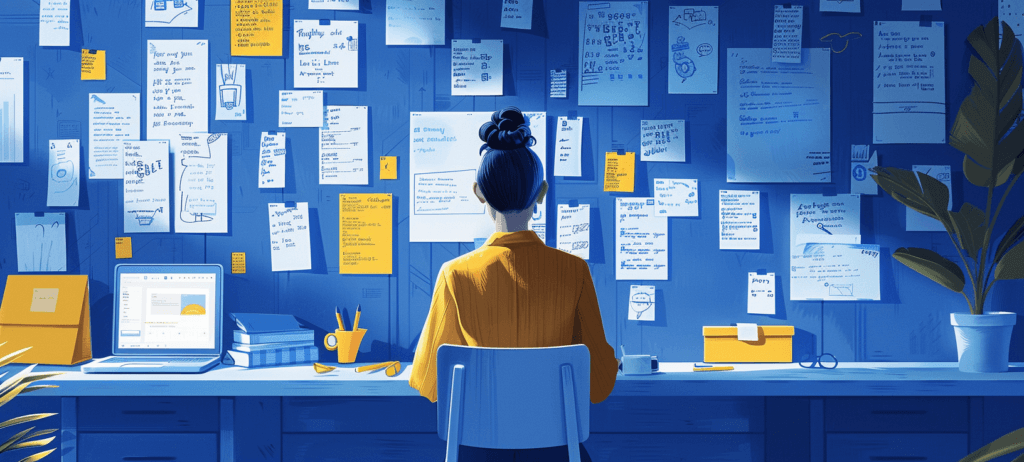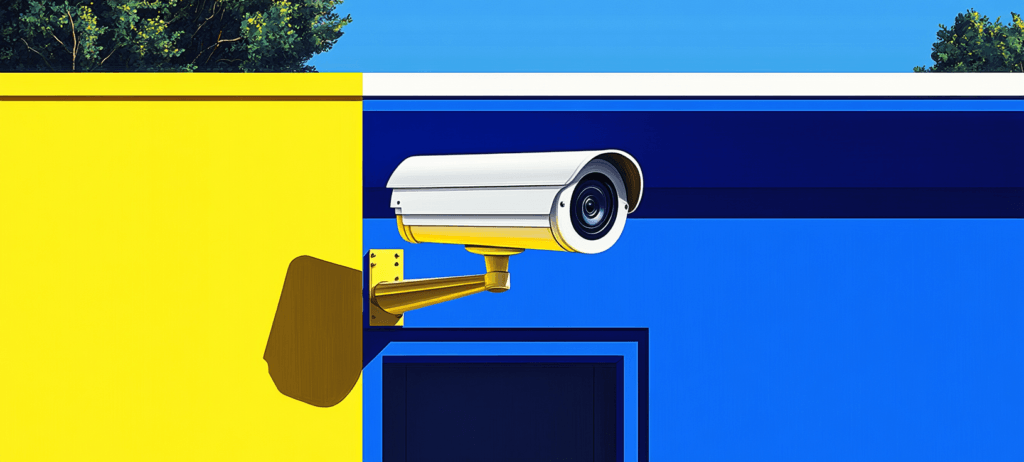-
 Published: Nov 4, 2025
Published: Nov 4, 2025
-
 20 min. read
20 min. read
-
Summarize in ChatGPT
-
 Matthew Gibbons
Matthew Gibbons Senior Data & Tech Writer
Senior Data & Tech Writer
- Matthew Gibbons is a Senior Data & Tech Writer at WebFX, where he strives to help businesses understand niche and complex marketing topics related to SEO, martech, and more. With a B.A. in Professional and Public Writing from Auburn University, he’s written over 1,000 marketing guides and video scripts since joining the company in 2020. In addition to the WebFX blog, you can find his work on SEO.com, Nutshell, TeamAI, and the WebFX YouTube channel. When he’s not pumping out fresh blog posts and articles, he’s usually fueling his Tolkien obsession or working on his latest creative project.
How can your brand succeed at earning user trust in an Internet landscape filled with growing distrust?
If you’re not already asking that question, you definitely should be. Trust is essential for brands like yours, which depend on cultivating online trust to earn new customers. But trust has been getting harder to come by on the Internet in the last few months, and the culprit is simple: AI video.
AI video has been around for a while. But in truth, it’s rarely been very good. (Remember those legitimately horrifying Will Smith spaghetti videos from a few years ago?) Today, though, that’s changing. In the last couple of months, we’ve seen the release of some new tools that are reshaping the conversation around AI video.
A lot of people have thrown out their two cents regarding the general impact of these tools, particularly their impact on online trust. But we’re here to get specific about what it means for businesses trying to market themselves online. Here’s an overview of what we’ll cover:
- What’s happening with AI video?
- How AI video impacts online brands
- Should marketers be using AI video tools?
- How brands can adapt to AI video
Let’s start by exploring what the current AI video landscape looks like.
What’s happening with AI video?
Earlier this year, a viral video swept across social media showing a group of rabbits hopping around on someone’s trampoline. Most of the initial reactions were from people who thought it was cute. Then came the bombshell: The entire thing was AI-generated.

Across all the various reactions to the news, the surprise was evident. “I can’t be the only one that thought it was real,” read one comment under the original TikTok video, while another agreed, “This is the first AI that has ever got me.”

But the trampoline bunnies were only the beginning. That video went viral at the end of July, and though it fooled a lot of people, there were still some clear AI giveaways to those who paid attention. Within a very short time, though, those giveaways had become a lot less common.
New AI video tools change the game
Less than two months after the trampoline bunny incident, two new AI video tools rolled out to the public: Sora AI 2 and Meta Vibes. Both of these tools function as social platforms where users can generate and share AI videos.
As downloads of these platforms surged and users began sharing the videos they created, two things became readily apparent.
First, AI videos are quickly becoming much more widespread. Sora and Vibes made AI video creation quicker and more accessible than ever, and the result has been a deluge of AI video content online — not just on the original platforms, but on other sites like TikTok and Facebook as well.
The second truth that came to light was the rise in quality that these tools have brought. Though still not perfect, the content produced by the new platforms — especially Sora — is vastly superior to any AI videos seen previously (at least, any AI videos produced by such publicly accessible tools).
As a result, AI videos are getting harder and harder to distinguish from real footage. Even the once-obvious tells of past AI content are starting to disappear.
AI video fuels a crisis of trust online
Remember how many people got fooled by the trampoline bunnies? Now even more people are getting taken in by videos depicting things like owls carrying their babies on their backs and mobs looting Walmart stores.
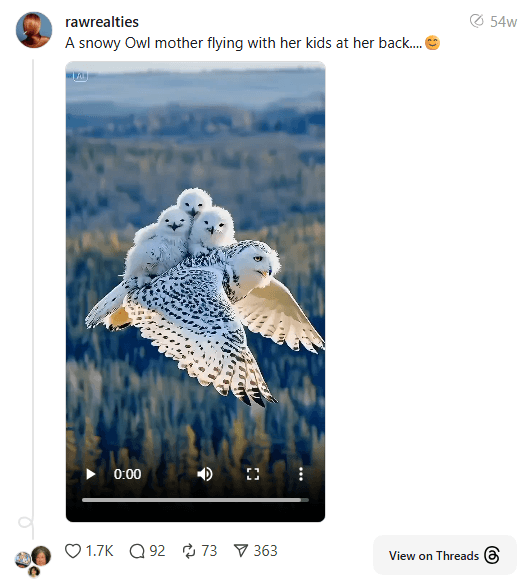
Many of these videos were posted for the sake of humor or experimentation. But others seem to be circulated with the deliberate intent of deceiving people. In addition, some AI video creators have taken delight in depicting public figures (often deceased ones) in unflattering positions.
AI videos may have legitimate uses, but there’s no denying that the more these videos appear on social media, the more people find themselves losing confidence in the authenticity of what they see on the Internet. That has led to what the LA Times dubbed an “online trust crisis.” Even real videos, if they show something questionable, leave people uncertain if they’re actually AI-generated.
In light of all this, there’s been a great deal of concern among many online users, particularly given how fast everything is happening. If AI video is already this hard to distinguish — and already being used so deceptively — what should we expect the Internet to look like in the future? How do we adjust to this new reality?
How AI video impacts online brands
One of the groups most impacted by the changing landscape of AI video is digital marketers. Marketing works by creating trust between users and brands, and it does that largely through online content — including video. But when users are inherently more suspicious toward the content they see online, it becomes a lot more difficult to generate the trust necessary to drive conversions.
The unfortunate reality is that even before the latest AI video tools came along, many companies were already resorting to deceptive AI practices. Numerous ecommerce sites have been caught using AI-generated product photos, and real estate listings have been found doing the same thing.
And now we’re entering the next phase of deceptive branding, brought to you by AI video. Those realtors I mentioned? They’re now posting fully AI-generated house tour videos, created with the help of realtor-specific AI video apps like AutoReel.
To be clear, this doesn’t mean that AI videos can (or will) be used only for deceptive purposes. As I said earlier, there may well be legitimate uses for this technology (as we’ll discuss later on this page).
Nonetheless, the deceptive use of AI video by some companies has a way of shifting users from a general distrust of online content to a more specific distrust of online brands. Even if your company doesn’t use AI video at all, there’s no way for your audience to be sure of that. Every commercial you run, every product tutorial you post, could be generated by AI.
That’s not even to mention the possibility of someone else creating AI videos that violate copyright or misrepresent your brand. An angry customer or online troll would have to exert very little effort to generate fake videos showing your products malfunctioning or your employees being rude, which could seriously damage your reputation.
As for copyright violations, they’re already happening. Several companies — including Disney and Warner Bros. — are currently suing the AI image generator Midjourney for exactly that. With AI images facing legal penalties, AI videos are almost certainly next in the line of fire.
The good news
If you’re starting to feel a little freaked out by everything I’ve been describing, take a deep breath — it’s not actually the marketing apocalypse it might sound like.
In reality, most people probably don’t assume that all the content they see is AI-generated (if anything, it’s the opposite). And if your company works to build a brand rooted in honesty and integrity, even the more suspicious people won’t assume the worst of you.
Furthermore, there are ways of using AI video that don’t sow distrust, at least in theory. As is often the case when a new technology is first released, it’s kind of the wild west out there right now, but the coming years will hopefully see many brands restoring online trust through a cautious and ethical approach to video marketing.
All that to say — it’s okay. Your digital marketing campaigns aren’t going to suddenly stop driving conversions. Sure, it’ll take some time and effort to adjust to the changes brought on by AI video, but you’ll be all right in the meantime. Keep in mind that these changes impact the entire market, not just your business!
We’ll talk through some ways to adapt to the impact of AI video a little further down the page. But before we do, there’s one more question worth considering.
Should marketers be using AI video tools?
So far, I’ve only talked about the impact of other people using AI video tools. But you might be wondering if you should use them in your marketing. Maybe you’ve already used some other types of AI tools to help you with your campaigns, and you’re wondering if you should add an AI video platform into the mix.
Before I go on, let me briefly clarify what I mean when I say “AI video tools.” There are some tools out there that use AI to help you put together videos based on existing footage. The AI might help you edit the footage or superimpose text or music, but it doesn’t generate the video itself.
For the purposes of this page, we’re not talking about those types of platforms. We’re looking specifically at generative AI video tools. With that in mind, let’s return to our original question: Should you be using AI-generated videos in your marketing?
To answer that question, let’s look at some pros and cons of using AI video platforms.
Pros of using AI video for marketing
Let’s start by talking through some of the potential advantages of using AI video platforms in your marketing strategy. Those advantages include:
- AI videos may come with lower production costs
- You can use AI to create quick prototypes for human-made videos
- Sora and Meta Vibes can serve as new social platforms
Let’s get into the details below.
1. AI videos may come with lower production costs
Cameras, sets, teleprompters… all these things are required to film high-quality videos. But they’ll also cost you a good bit of money, and you may not be able (or willing) to spare the budget for them at the moment.
In that case, AI video is one method of creating video content at a lower cost. You can type in a prompt and generate something without having to blow your budget on the equipment needed to film it yourself. For many companies, that alone makes AI video seem worth trying out.
2. You can use AI to create quick prototypes for human-made videos
Even if you don’t feel comfortable using AI-generated videos for the final product, you may still find them helpful for creating prototype footage.
In the same way that you might use ChatGPT to help you draft an outline for a human-written blog post, you can use a tool like Sora to generate a concept video for something you ultimately plan on filming yourself. Or, you can use it to create temporary filler clips for footage you haven’t filmed yet.
In this use case, the AI-generated clips won’t remain in the final video you publish on your website or social media. But they can still be a valuable part of the planning and production process.
3. Sora and Meta Vibes can serve as new social platforms
Sora and Meta Vibes don’t just let you create AI-generated videos. They also let you share those videos right there on the platform.
Essentially, these tools serve as their own social media platforms. That means there’s value in adding them to your social media marketing strategy. You can create and share content in Sora and Meta just like you do on other social sites, with the twist that these platforms are dedicated specifically to AI video.
Focusing your AI video strategy on those native platforms also helps you sidestep the trust issues I talked about earlier. You don’t have to worry about users distrusting your AI-generated videos if you’re sharing them on a platform where everything is AI-generated.
Users know what they’re getting going in, so they can focus on your brand messaging rather than getting distracted with trying to figure out if what they’re seeing is real or not.
Issues with using AI video for marketing
If you’re considering using AI video in your digital marketing, you should be aware of the many possible issues that can come from doing so. Here are a few of the most significant ones:
Let’s break those down in more detail.
1. Struggles standing out
One of the biggest issues with using AI video content — and, really, AI content in general — is that it all just kind of blends together.
Standing out from your competitors is essential in digital marketing — you won’t drive conversions otherwise. Unfortunately, relying too heavily on AI video completely negates that. I once heard AI content described as “the average of all the human content it learned from” — always perfectly in the middle, never standing out in any way.
When every business is using AI to generate their videos, you end up with what’s been called a “sea of sameness.” And with the rate at which people are creating AI videos, that sea will soon be an ocean. If you’re putting out AI-generated footage just like everyone else, you’ll quickly get lost in it.
2. Risk of customer backlash
There have been several different studies on how people view AI content, and the results are pretty clear — a lot of people don’t like it.
Per one of the more recent studies, 57% of Americans say they view AI as having a high societal risk due to it hurting human creativity, skills, and connections. Additionally, 76% say it’s very important to be able to tell which content is AI-generated — but 53% lack confidence in their ability to do so.
These aren’t just lifeless statistics, either — we can observe a lot of this frustration in action, especially in branding contexts.
To name just one example, there was a huge wave of backlash in response to Coca-Cola’s “soulless” 2024 Christmas ad, which was mostly generated with AI. Despite this, the brand recreated the same ad — once again using AI video — in 2025, prompting even more frustration from consumers bewildered by the company’s apparent refusal to learn its lesson.
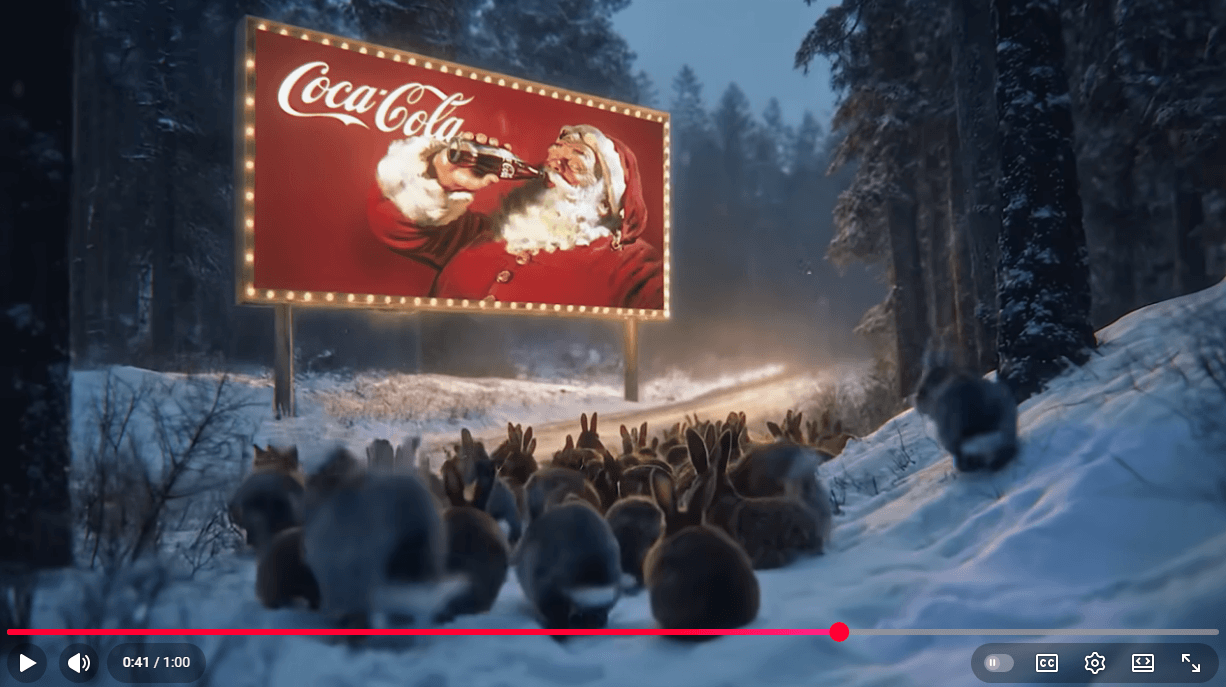

Perhaps even worse than users getting mad at your AI-generated videos, though, is the possibility of those users simply ignoring them. That’s likely to happen as more and more AI content fills up social media, causing even the more AI-positive users to burn out on it. In the words of one marketer, “The thing about AI content is that the more of it people see, the less they want to see.”
3. Sustainability concerns
For many businesses, sustainability is an important priority. In fact, some companies make it a key part of their branding, particularly in the professional services industry.
If your company prioritizes sustainability, great! But you should be aware that using AI-generated videos may undermine that. That’s because AI video generation takes up an insane amount of energy — a five-second video requires about 3.4 million joules. That’s equal to the amount of energy used by running a microwave for over an hour.
The environmental impact of generative AI is well-documented, so if your audience sees you using AI-generated videos while claiming to care about sustainability, you can bet they’ll be quick to call you out on your hypocrisy.
4. Lack of efficiency
When people advocate for using AI video, they typically argue that it’s a lot faster and easier than filming real footage. You just type in a prompt, and voilà — you have a video! In theory, this reduces the amount of time, effort, and human labor required to create video content.
In truth, though, it’s not nearly as simple as you might think. Not every video generated by Sora (or similar tools) is high-quality, and it often requires a ton of different tries before you finally get something good. In one case study, a marketer had to go through 58 cuts to get even four seconds of usable video!
While I won’t deny that generating an AI video is easier than, say, filming a big-budget action film — all-day shoots, helicoptering out to remote locations, and implementing lots of CGI — that’s hardly what a typical social media brand video looks like. More often, these videos are short, simple, and filmed right in the office.
The takeaway here is that using AI-generated video still requires a ton of time and effort, not to mention the human employees required to sit there generating video after video in the hunt for something decent. For some companies, it may be a lot quicker and easier to just film your own footage (and/or use existing stock footage).
Using AI video in your marketing: Yes or no?
So, what’s the verdict? Should you use AI video in your marketing?
At the end of the day, that comes down to your unique business needs and priorities. Do you have budgetary reasons for using AI video? Do you think it would fit with your brand?
It also depends on your audience. Only you can know how your customers would react to seeing AI video in your marketing. If you know you’d get a lot of backlash, it might be better to avoid it. But if you genuinely think they’d respond positively, then by all means — give it a shot.
Finally, it depends on how you use it. That part is crucial. It’s easy to misuse AI video in a way that decreases trust in your brand, and you definitely want to avoid that. If you’re not sure what counts as a good use of AI video, it may be a good idea to partner with a professional marketing agency that can give you some guidance.
How brands can adapt to AI video
Like I said earlier, AI video will almost certainly impact your brand in some way, whether you use it in your own marketing or not. That means you need to adapt your strategy to account for all the changes and challenges we’ve discussed on this page.
To help you with that, here are three tips on how to adjust your digital approach:
Let’s look briefly at each of those tips below.
1. Use AI video cautiously
Like I said a moment ago, it’s up to you whether or not to use AI video. For some companies it might be beneficial, but others might find that it’s not worth it, given how many issues it has and how unpredictable the results can be.
If you do opt to use AI video, though, you should tread with caution to ensure you’re using it properly. But what does it look like to be cautious with AI video? Here are a few things to include in your approach:
- Meticulously check your AI videos for quality.
- Make sure your AI video footage doesn’t commit copyright infringement.
- Be transparent about the fact that the videos were generated with AI.
- Don’t generate whole videos with AI — only short snippets in otherwise human-made videos.
Following those steps will help you avoid some of the major AI video missteps I mentioned earlier.
2. Monitor for brand misrepresentations
We’ve already seen how AI videos can be used (whether intentionally or accidentally) to create content that violates copyright or poorly represents brands. It’s always possible that your brand could find itself in the crosshairs of that content, so I’d recommend monitoring for any potential violations.
The good news is, social listening — which involves monitoring social media for mentions of your brand — is already an important digital marketing tactic, so your AI video monitoring can fit neatly into that approach. If you see any problematic AI videos among your brand mentions, be sure to have your PR department jump on it promptly.
I’m not saying this is likely to happen. In fact, there’s a good chance it won’t. But it’s better to be safe than sorry, so it’s worth keeping an eye out for any potential cases of brand misrepresentation or copyright violation.
3. Emphasize the human element
Earlier, I described how AI content has a way of blending together — all of it average, none of it exceptional. And yet, the Internet is quickly being flooded with it. That means for your brand to stand out, you need to double down on the human element of your brand.
Think about what can set your brand apart from the competition, and then really emphasize that in your video content. Lean into things that AI can’t do. In particular, focus on E-E-A-T, which stands for Experience, Expertise, Authority, and Trust.
Demonstrating E-E-A-T in your marketing is already essential for ranking in Google search results and getting cited in AI responses, but it also helps you stand out in a sea of AI content. That’s because AI is incapable of having personal experience or authority, so when you demonstrate your own experience, it sets your brand apart.
Harness AI video responsibly and effectively with WebFX
It’s true that the spread of AI video is making trust harder and harder to come by online. But in the midst of this growing desert of uncertainty, your business can be the oasis of trust that draws users in. You just have to take the time to demonstrate your brand’s honesty and integrity, and to build unique video content that sets you apart.
As I said several times on this page, there are valid and helpful uses for AI video, and your business can find success by pursuing those use cases. But you shouldn’t go at it alone. If you want to reach your full potential with AI video, consider working with a trusted partner that knows how to make AI-assisted marketing excel — a partner like WebFX.
Whether you prefer to use AI video or rely on traditional methods, WebFX can help. We offer top-tier video marketing services to help you reach a wider audience on YouTube and social media, and we know how to reoptimize your marketing to satisfy E-E-A-T requirements. That’s why we’ve been so successful at driving revenue for our clients over the last 29 years.
Interested in partnering with us? Just give us a call at 888-601-5359 or contact us online today!
-
 Matthew Gibbons is a Senior Data & Tech Writer at WebFX, where he strives to help businesses understand niche and complex marketing topics related to SEO, martech, and more. With a B.A. in Professional and Public Writing from Auburn University, he’s written over 1,000 marketing guides and video scripts since joining the company in 2020. In addition to the WebFX blog, you can find his work on SEO.com, Nutshell, TeamAI, and the WebFX YouTube channel. When he’s not pumping out fresh blog posts and articles, he’s usually fueling his Tolkien obsession or working on his latest creative project.
Matthew Gibbons is a Senior Data & Tech Writer at WebFX, where he strives to help businesses understand niche and complex marketing topics related to SEO, martech, and more. With a B.A. in Professional and Public Writing from Auburn University, he’s written over 1,000 marketing guides and video scripts since joining the company in 2020. In addition to the WebFX blog, you can find his work on SEO.com, Nutshell, TeamAI, and the WebFX YouTube channel. When he’s not pumping out fresh blog posts and articles, he’s usually fueling his Tolkien obsession or working on his latest creative project. -

WebFX is a full-service marketing agency with 1,100+ client reviews and a 4.9-star rating on Clutch! Find out how our expert team and revenue-accelerating tech can drive results for you! Learn more
Try our free Marketing Calculator
Craft a tailored online marketing strategy! Utilize our free Internet marketing calculator for a custom plan based on your location, reach, timeframe, and budget.
Plan Your Marketing Budget
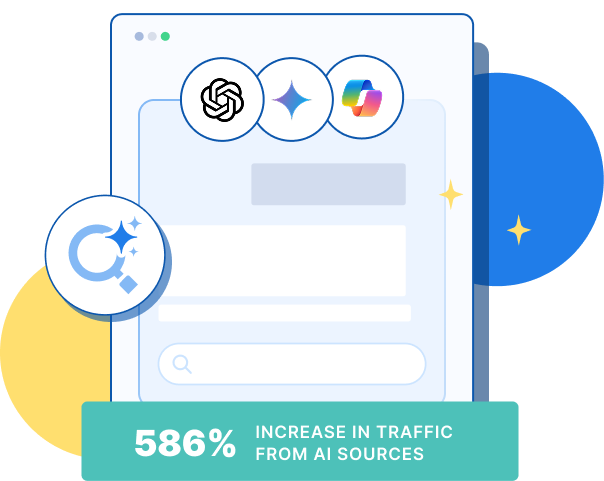
See AI Marketing in Action
Explore how WebFX helped a regional brand get discovered in AI search experiences — proving what’s possible with today’s AI-driven marketing!

Proven Marketing Strategies
Try our free Marketing Calculator
Craft a tailored online marketing strategy! Utilize our free Internet marketing calculator for a custom plan based on your location, reach, timeframe, and budget.
Plan Your Marketing Budget



